The Sicilian city of Catania had always been unknown to Lorenza Bacino, so when the opportunity arose to visit with a local, she jumped at the chance…
With open hearts, Sicilian journalist Francesca Marchese’s family welcomed me into their home in the Catania hinterland and I felt like a prodigal daughter returning after a long stint abroad. In reality the prodigal daughter was Francesca, who is now London-based, and her parents were over the moon that she was home. The privilege was all mine though, as authentic local food began to flow from stove to table like lava from Mount Etna. Declining wasn’t an option, so I settled in for the full Sicilian experience.
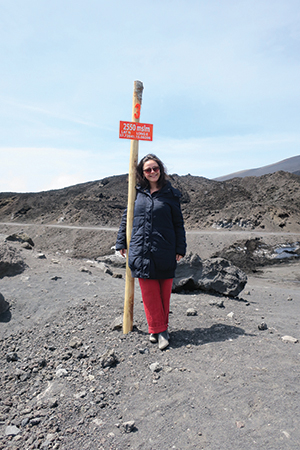
I had expected to be left to my own devices to explore this extraordinary city of ancient and modern, but a flurry of phone calls soon secured a succession of appointments, with the ebullient Francesca firmly in charge and making sure that I would get as much as I could out of my short visit to her home town.
Soon we were trundling down the hill towards the city in her little white Fiat for an evening visit to Palazzo Biscari. One of the phone calls that had been made had apparently resulted in Ruggero Moncada, descendant of the illustrious IV Prince of Biscari, agreeing to an impromptu visit of his grand family home, which comprises some 700 rooms.
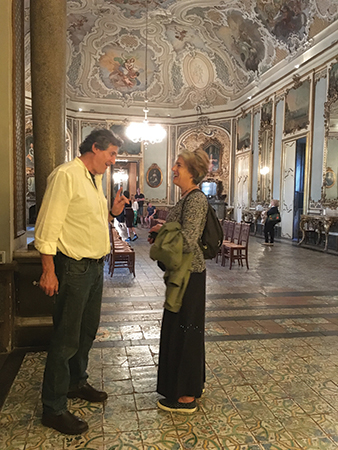
This is a private residence, though allowances are made for public visits – generally not at this time of day, however…
The Palazzo Biscari was built in stages after the 1693 earthquake that destroyed the town and took until 1763 to complete. It overlooks the sea and the Archi della Marina – a chain of grey and ivory coloured stone arches. Up until the 1930s, the sea flowed under a third of the arches, enabling fishermen to reach the shore more easily after a day working at sea.
The gorgeous exterior of the palazzo is by Baroque architect Alonzo di Benedetto; the interior is sumptuously Rococo and houses a staggering array of paintings, archaeological treasures and personal artefacts of which we saw but a smidgeon. We marvelled at the beauty of the huge, guitar-shaped ballroom replete with frescoes, mirrors and paintings, and laughed at Ruggero’s tales of family intrigue and wartime capers.
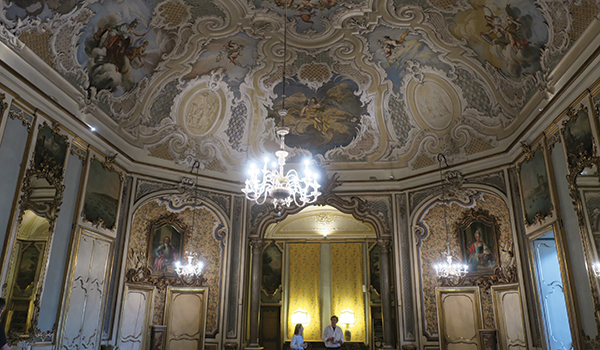
We heard how the elegant ballroom served as a tennis court during WWII for Montgomery’s troops. Montgomery was loathe to risk the destruction of the beautiful façade for the sake of his cannons during the Allied landings, so he used the ballroom as a place of entertainment instead. Somehow a tennis ball punctured a priceless painting of a family member. The unfortunate lady still has a hole through her stomach. Several of the mirrors are dented and traces of the lines of the tennis court are still visible on the floor.
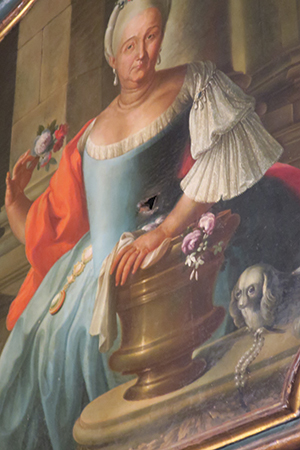
Saint Agatha
No tour of the city of Catania is complete without a visit to Piazza Duomo and the Cattedrale di Sant’Agata, the patron saint of the city. Images and references to her are everywhere. Her remains lie in the Cameretta, the ‘small room’, in a shrine at the rear of the church.
She died as a teenager after refusing the advances of the Roman prefect Quintanius, who responded by cutting off her breasts. Agata refused to give up her Christian faith, and her virginity, and is said to have died in prison. She is celebrated every year in the city between the 3rd and the 5th of February, when a solid silver carriage, the Fercolo, is dragged through the streets – an event that attracts many visitors.
You can see the impressively ornate Fercolo close up in the Museo Diocesano, next to the Duomo. I’d love to experience the fanfare of the procession through town during the festival – that will have to be on a return trip. Meanwhile, the climb up to the terrace above the Porta Uzeda, with its sun-drenched views along the Via Etnea to Mount Etna, was glorious, as Francesca pointed out the main sites from above.
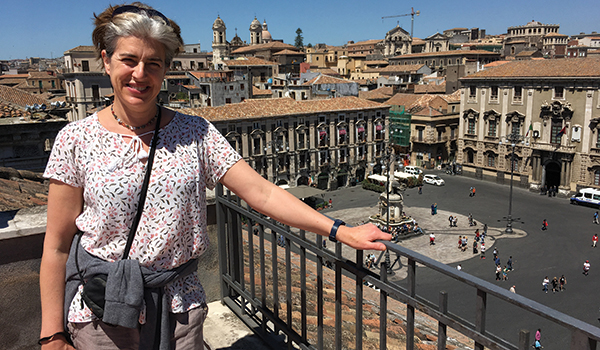
We were lucky enough to gain access to the Roman baths beneath the museum. The Terme Achilliane is a complex of 3rd-century baths that had been covered by lava in the 1669 eruption of Mount Etna and the 1693 earthquake.
Ignazio Paternò Castello, the Prince of Biscari, began excavating in the 18th century. A small part of a more vast complex is visible today beneath the piazza in the form of a large rectangular structure with vaulted ceilings and four huge pillars. You can see the remains of the tepidarium and frigidarium. In the centre is the main bathing area, which would have been covered in marble. The entrance lies to the right as you face the cathedral but it isn’t overly visible or advertised. I highly recommend a visit, as the underground illumination provides for a truly atmospheric experience.
We wandered the streets, marvelling at the beautiful Baroque palazzi, the archaeological remains of Catania’s 1st-century Theatre and Odeon, built upon layers of history from prehistoric
to Greek to medieval – and everything in between.
We crossed Piazza Carlo Alberto, scene of Catania’s daily A Fera o Luni market, where a group Bangladeshi migrants were now playing cricket in front of an imposing 18th-century church, much to the bewilderment of the locals. We arrived at the city’s largest gardens, the 19th-century landscaped Villa Bellini, which is full of sub-tropical plants and towering palm trees, and has a huge Moreton Bay fig tree.
As we strolled down the Viale degli Uomini Illustri, I learned about the city’s most revered citizens. We swung by the Bar Savia on Via Etnea for a restorative arancinu, a rice ball stuffed with meat sauce and cheese.
We also explored inside the vast, 13th-century Castello Ursino, a military stronghold, former royal Aragon residence, prison, and now home to Catania’s Civic Museum. My head was awhirl as Francesca explained her city’s rich cultural and artistic heritage spanning millennia and incorporating influences from the Roman Augustan period, from Byzantine and Arab rule, from the Norman domination with its monasteries and cathedrals, and the Spanish Aragon dynasty, which saw the founding of the first university on the island.
And it was to one of the university buildings that we headed, located in the glorious surroundings of the former Monastero dei Benedettini di San Nicolò L’Arena. I couldn’t imagine a more inspiring and gracious place of learning. This is a jewel of a UNESCO World Heritage building, with its cloisters and gardens where modern and ancient architecture are juxtaposed.
Students nestle inside alcoves in the bay windows overlooking fountains and courtyards. How gorgeous to lose yourself in reveries beneath stucco domes and marble columns, among the cacti, the jasmine and the palm trees.
Former monastery rooms have been converted into modern lecture theatres and are interspersed with traditional wooden rooms with spiral seating arrangements. There is a monumental staircase decorated with Neo-Classical bas-reliefs. The antique libraries inside the former monastery, the Biblioteca Civica and the Antonio Ursino Recupero, are beautifully decorated and their shelves hold some 270,000 books and manuscripts.
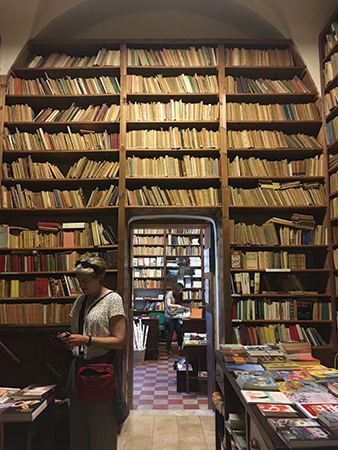
Pop into the Palazzo dell’Università too, in Piazza Università, off the Via Etnea. The original 15th-century building was destroyed in the earthquake of 1693, so today’s building is largely 18th century – and very majestic it is too. It’s significant for its internal courtyard, its frescoes, and the tapestry in the main auditorium. The university library was founded in 1755 and contains more than 210,000 volumes, some of which hark back to the Middle Ages.
Majestic Mount Etna
Every morning a different view of Etna greeted us. “She,” says Francesca (for Etna is a woman, I am told), “is a benevolent presence for the citizens of Catania. We are not afraid of her constant volcanic activity. She is part of our lives. In fact, the windows in the house shake when Etna awakens.”
Etna is the tallest active volcano in Europe (at 3,332 metres), but she doesn’t explode like Vesuvius or Stromboli: she flows. Francesca explained how new craters are forming all the time as the magma tries to find a way out, creating cones along the slopes which in turn become blocked as the magma cools, creating the need for more outlets. Hence the widespread area that the mountain occupies and its varying green and grey hues. It’s surprisingly slippy and hard to climb on shifting lava, so proper boots, and a jacket for the wind, are essential. You don’t need to bring these items with you as you can hire them on the mountain quite cheaply.
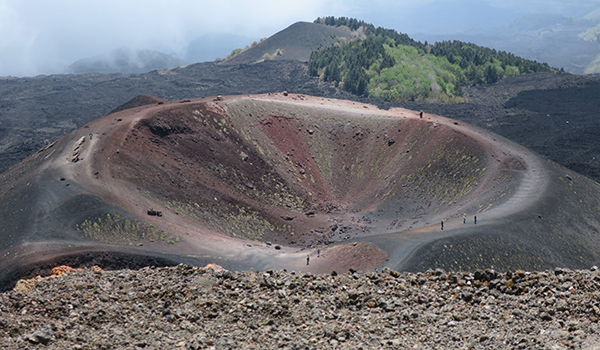
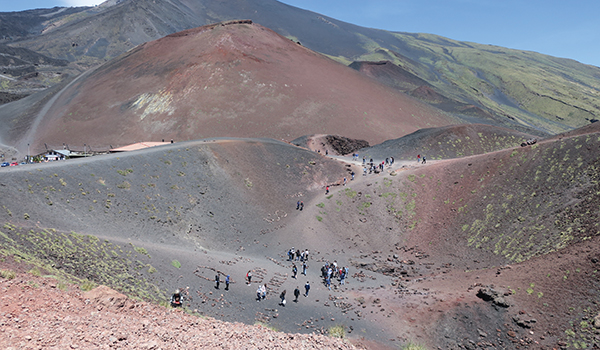
Etna draws your gaze and I lost myself in thought as I climbed and circled one of her many craters in a silver-grey moonscape. We took the cable car to above 2,500 metres and encountered huge chunks of ice on our hike. A jeep will take you to the summit areas with a guide for an extra fee.
Lava stone is an integral part of Catania’s architecture and it has been used for roads, sculptures, ornaments and even in the construction of modern buildings. Notably, the ancient, iconic Elephant Fountain in Piazza Duomo is made from lava stone. The soil also produces especially delicious lemons, pears, walnuts, pistachios, honey and, of course, strong Etna wines (Nerello Mascalese and Nerello Cappuccio are the main red varieties). Lava flow is hard to redirect, so over the centuries, Catania and its surroundings have changed shape and been refashioned according to the whims of their majestic mountain who watches over all.
About the writer:
Francesca Marchese is a London-based Sicilian journalist specialising in current affairs, migration and cross-culture. She is the founder of SicilyCulture, which organises events on Sicilian film, food and culture for a diverse community of Londoners. She also helps UK media in its coverage of Sicily. Previously she spent a decade in Sicily as a TV reporter. www.francescamarchese.co.uk
Lorenza Bacino is a London-based journalist and travel writer specialising in Italy, and a regular contributor to Italia!
